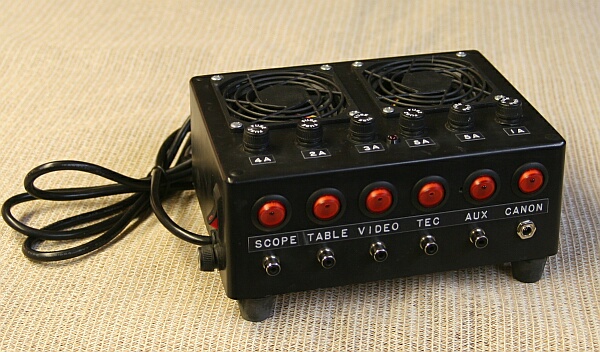The Power Box Project
Main Astronomy Page Image Gallery Main Page Projects Main Page  How it was built Testing & Performance |
|
|
Reliable, clean, safe power for our expensive stuff is something we should be able to take for granted, but sadly it isn't so. The forums and newsgroups I frequent have more sad stories related to power problems than I care to count. I fought my own battles with the cable snarls, wall warts that looked alike but weren't, ditto for the power connectors, etc. This project was meant to end the battles (and the worries). It does.
Explore the links on this page to see how this was built and how it performs. If you decide you want one of these for yourself, - contact me - and we'll work something out. Or feel free to use the information you find here to construct something like this for yourself. Different configurations for different cameras, total capacity, etc. can be designed and built. It won't be cheap, but it will be as bullet-proof and equipment-friendly as this old engineer knows how to make it. Read on! You'll like what you see! And now for the speech-making, caveats, etc.: Up front: NOTHING puts out clean power as well as a battery. So why not just use batteries? Batteries go dead - usually at the most inconvenient times, and sometimes they unexpectedly go dead between the time we charge them and the time we need to use them. Batteries fail for a number of reasons, and one bad cell in a pack can ruin your whole evening at the telescope (or ruin the whole pack). Sometime we just forget to charge them or buy fresh ones. The goal is to build a supply that looks as much like a battery as possible to the equipment connected to it. Off-the-shelf consumer-grade power supplies have a whole list of their own problems. The first problem is that most of them don't really imitate a battery as well as their manufacturer would like us to believe. "Wall Warts" aren't usually high-quality power supplies, and sometimes we forget which Wart was plugged into what in the dark. This story does not always have a pleasant ending. For me, the equipment connected includes: A 12" LX200, the LED light bar that illuminates my computer keyboard, the general purpose LED light stand that illuminates everything on my table except the computer, any one of several TEC units that keep my cameras cold (up to 4 Amps), an Astro Video 2000 camera and its dedicated 4" monitor, and a Canon Digital SLR . There are a lot of dollars connected to this unit, so SAFE, RELIABLE POWER is the name of the game. Bells and whistles are secondary. Transformer-based supplies can be rugged and reliable, but are heavy, tend to run hot and are only 30-40% efficient. Today, switching power supplies that don't need a heavy transformer can be reliable, cool running and are up to 95% efficient. Not all are created equally. I tested a number of switching power supplies from various manufacturers, looking for suitable units. The spec: A convection-cooled unit (per the manufacturer) that was rated for 150W (12.5A) continuous output. That really means that under light loads, no fan would be required. We'll provide forced air when it's needed. The unit had to run at max load for hours without a fan and not burn up. Regulation had to be better than 1% at all loads, and total noise less than 0.5%. Those are some tough requirements, but I did find several units that measured up. Additional requirements for the finished unit: Each power outlet had to be filtered and fused to match the connected load. Filters work best when matched to their load, so each outlet was designed to operate a particular piece of gear (or something that draws about the same power). Should the unthinkable happen and the voltage of the unit go too high, an independent "Crowbar Circuit" stands guard over the main bus, and reacts instantly to a too-high voltage condition. It clamps the output as fast as a transistor can react and the resulting dead-short current blows the main bus fuse. The trigger point for the crowbar circuit is a design point that deserves a brief discussion. As-built, this unit triggers at 12.5V (0.3V above the regulated output of the main supply). If you intend to operate from a 12V storage battery, it is possible for the battery to output up to 15V if it has just been removed from a charger (or if a charger is connected while running). The trigger point can be made selectable, or hardwired to the highest expected voltage. My personal preference is to have the trigger set as low (and therefore as safe) as possible while still allowing normal use. |